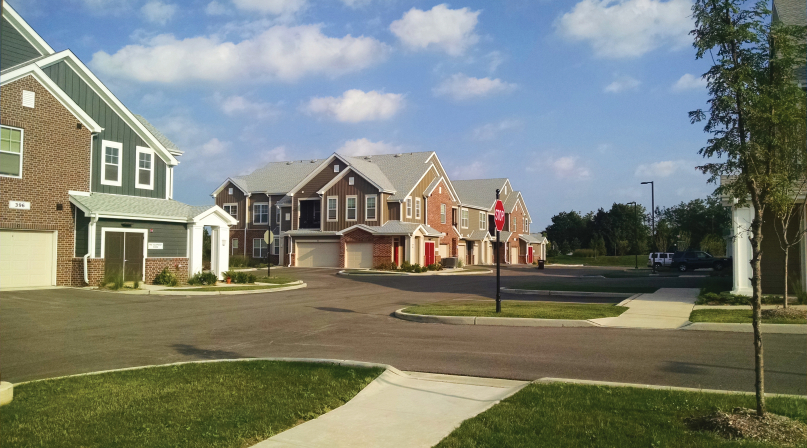Share
Line: | @NACoTweets: Ill. program sites mixed-income housing outside the urban core http://bit.ly/1OfAgcx |
A group of Chicago-area counties could teach a lesson to their counterparts nationwide on creating affordable housing in more economically diverse neighborhoods.
Since 2002, several county and city housing authorities have participated in a Regional Housing Initiative (RHI) that provides lower-income residents access to rental housing throughout the region, versus in a particular municipality.
The housing is located in “opportunity areas” — often in suburbs — which RHI defines as close to jobs, training opportunities, good schools, transportation and recreation.
RHI has supported at least 467 apartments in 30 developments in 23 “quality” communities since its inception, per data from the region’s Metropolitan Planning Council (MPC), based in Chicago.
“I think this is a really promising model that could be a very important tool for helping to address these issues at a regional scale (across the nation),” said Elizabeth Kneebone, a fellow at the Brookings Institution’s Metropolitan Policy Program. She said Baltimore and St. Louis have expressed interest.
The Regional Housing Initiative provides operating subsidies in the form of project-based vouchers to owners of rental properties through the U.S. Department of Housing and Urban Development’s (HUD) Housing Choice Voucher Program, formerly known as Section 8.
Participants in the initiative are the housing authorities of Cook, DuPage, Lake and McHenry counties, and the cities of Chicago, Joliet, North Chicago, Oak Park and Waukegan. All are bound by an intergovernmental agreement, said Breann Gala, who manages the program for the MPC.
The vouchers remain with the apartments, and aren’t portable with the tenants as is more typical.
A development’s owners receive reasonable market rents from the housing authority for a 15-year period, which can be extended. For example, Gala said, if a unit rented for $1,000 a month, the property’s owner would receive $600 in voucher payments, guaranteed for 15 years. Tenants would cover the balance from their incomes. The guaranteed income over a fixed period of time is what developers and owners find attractive about the program, she added.
Julie Biel Claussen, executive director of the McHenry County Housing Authority, said families seeking housing are placed on a centralized waiting list. “When we began this program, we sent letters to everybody on our waiting list as did the other housing authorities. Some of those people may have come from Chicago, or they may have come from Lake County, or one of the other cities within our metro area.”
Typically, Chicago and Cook County’s housing authorities have received higher levels of HUD subsidies than their suburban neighbors because the need is greatest there, according to Richard Monocchio, executive director of the Housing Authority of Cook County. However, by pooling resources, subsidies can be used across jurisdictional boundaries.
When the program started in the early 2000s, Gala said, there was a shortage of rental housing near suburban job centers, and commute times to jobs outside of Chicago were increasing. At the same time, poverty in the suburbs was on the rise.
“Historically, we have put affordable or public housing in high-poverty areas and often in segregated communities,” she added, such as the infamous Cabrini-Green and Robert Taylor Homes high-rises in Chicago, now demolished. “This is a model for doing this differently.”
While desegregating public and subsidized housing isn’t the RHI’s intent, it can, coincidentally, have that effect.
“It’s a consequence, but it’s actually not the goal,” Claussen said. “It’s more of an economic integration than a racial integration program.”
Fair housing has been much in the headlines this summer: In June, the U.S. Supreme Court ruled that policies which unintentionally segregate minorities in poor neighborhoods violate the Fair Housing Act. The act bars not only racial discrimination but also prejudice based on national origin, religion, sex, disability and the presence of children.
Monocchio said two-, three- or four-bedroom units often face opposition from suburban neighborhoods. “Some communities have exclusionary zoning policies that make it hard, for example, to site multi-family housing,” he explained. “So we have the toughest time getting family sites built into opportunity areas, but it is a strong focus of ours.”
On July 8, the U.S. Department of Housing and Urban Development (HUD) issued its final rule on Affirmatively Furthering Fair Housing.
And Gala believes the RHI can be used to further fair housing goals. “Hopefully, … we’ll be able to engage even more communities, and counties and other government entities in a discussion around where we should be supporting affordable housing across the regions.”
As evidenced by the recent, fact-based HBO series, Show Me a Hero — based on Yonkers, N.Y. residents’ opposition to public housing in their neighborhoods in the late 1980s — success in siting mixed-income housing outside the urban core isn’t guaranteed.
“I won’t deny that there have been developments that we have been interested in supporting that have not moved forward because they get stuck in the political process,” Gala said.
“There have been those cases from time to time, where there is strong community pushback …. But we do our best to make sure that the developments that we support are furthering local plans, that they’re of high-quality construction.”
Monocchio said creating affordable housing in areas with good schools and access to jobs and transportation is designed to give low-income families a “leg up.”
“We have come to learn from experience how important it really is to consider place-based solutions when we’re siting housing, especially when we’re using federal resources, especially if kids are involved,” he said.
“Those kids should have the same access to quality schools as everybody else.”



